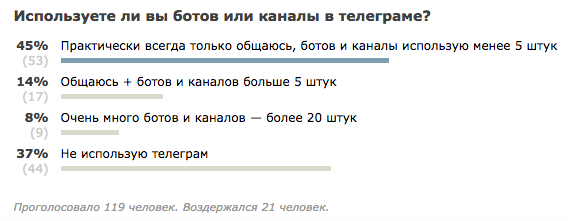Are bots and channels popular in messengers?
- “Have you seen my bot?”
- “Are you subscribed to my channel in the telegraph?”
- “100,500 channels in the telegraph, about which no one knows, but about which we will write as we have nothing to write”
I think the phrases above tell you a lot. Many news sites are crammed with articles about bots and channels in the telegraph, and in the comments below people write even more channels. In each channel, there are literally 5-10 subscribers.
Everywhere they write bots and small tutorials of the form “How to write a bot in a minute, so that it strokes your clothes, looks for girls and can do this in the supermarket of telegrams”.
')
June 30, 2015, 3 days after the release of the Telegram Bot API, we made a bot and wrote an article about it on Habr , then we had no idea that all this would result in total madness.
In the article we will try to prove that in reality bots and channels are practically unnecessary to anyone, and also tell you why you shouldn’t make another bot or another new channel.
Channel Collections
Typical example:
vc.ru/p/telegram-channels-1000

Various resources seem to be clogging up "airtime" by stuffing weekly channel selections. Maybe even get paid for it. In reality, feeds are similar to RSS, only they are less convenient. Even if you subscribe to all channels from one collection - you can no longer use a telegram - it will be clogged with a constant stream of messages. You will start turning off alerts from the channels, and soon you will stop reading altogether. That is why you can often see the channel with 1000 subscribers and 10-20 readings.
Channels in the telegram are even less effective than VKontakte groups.
I will explain with an example. A typical Vkontakte user may have about 100-200 groups in the list of subscriptions. He will have 5-10 groups, where he may go by himself and read new posts right there. He reads the rest of the groups through the tape, where the filtering of new VK algorithms takes place, as well as where he can scroll through the tape floor and not see hundreds of posts from the groups.
There is no common tape in the telegram, as a result, the user actually gets the same 5-10 channels where he comes in, and about 20-30 more where he doesn’t come in almost ever.
However, there is another problem, in the same interface where these 5-10 channels still have 5-10 dialogs of real users, so they will constantly conflict. It’s clear that a friend or girlfriend will probably win than a channel that pesters every 30 minutes with another post. As a result, in the reality of constantly visited, 2-3 channel channels will be released.
And most importantly - the number of users in a telegram is much smaller than in the same VKontakte. I can’t find any real statistics, but I haven’t yet met people who have an account in a telegraph, but not having a VC, but on the contrary constantly. The result is that the real possible audience, which will read the posts of your telegram channel 5-10 times less than that which reads your posts in VC.
Moreover, most likely you will get even less efficiency if most of the views of your posts come from the tape - users will be of little interest in reading you through telegrams. If you have a lot of fans, then perhaps the telegram will be convenient for you, since it will really be more convenient for them to read you also in the telegram.
The history of the formation of chaos
As I wrote before the habrakat, we made the bot 3 days after the release of the Telegram Bot API. We expected that only a small number of people and companies would make really good bots. As a result, everyone began to make news bots, and stupid ones - when they stupidly send you news from one source, the telegrams responded to this by making the channels functional and now anyone with 2 clicks can create a channel for themselves on any topic. It looks like everything is beautiful ... and a crutch.
Each thing must have its own task. Remember in the same VKontakte there are built-in games, but have they really shaken real PCs or mobile games? A long time ago there were bots in both ICQ and Jabber, but how many people began to rivet such bots instead of writing for example a real site?
Even if you take your fancy phone, you will notice that you are not using even 10% of its capabilities. During the day you make calls, write messages to your friends in the messenger, maybe take a photo a couple of times. The more you are busy with work or personal affairs - the less you use the phone and the less you use it.
When you have a phone, where you just need someone to write a message, several bots and channels in the same application still get in the way - will it be convenient for you? Let us remember the old idea of portals (sites) where, when entering, you will have everything in front of you, your e-mail, news, games, although mail.ru remained approximately the same, eventually defeated Google, which smashed everything.
Our statistics
Since June 2015, since the launch of the telegram in our system, only 10.5% have been using telegrams as a method of receipt. The statistics is simple - we have 3475 connected telegrams of devices and 32831 total. Moreover, 1459 devices are connected via web sockets, which work only when the browser is open. And 2671 connected via Email.
For comparison: we now have 11705 devices connected via a native application via Android. And 6956 are connected through an addition for chromium. And 5388 are connected via web-pushes.
Why didn't everyone suddenly start using the telegram?
It is not comfortable
The fact that telegrams are no more popular than VCs, and the fact that there are inconvenient to use many channels and bots, we have already written. But let's imagine the ideal situation - one PushAll bot versus a native application. Maybe here we will see what the telegram is more convenient.
The user receives an alert.
On telegram:
1. He sees a notification in which he received a message from the bot in a single text without a picture of the channel, without a title.
2. He clicks on it.
3. A dialog opens with a bot with a list of messages.
4. He clicks on the link from the message.
5. A browser opens with the site.
In native application
1. He sees a notification in which there is a title, text, picture of the notification or channel from which it came.
2. He clicks on it.
3. A browser opens with the site.
3 instead of 5. Each time there are 2 less actions. And this is a simple bot that sends notifications. In fact, the telegrams with channels come out exactly the same. The user is forced to click several times. And if you sent him several messages, he would have to look for the one that interested him. As a result, it turns out that time costs increase by 2 times.
And if you decide to make a bot in which you need to fill out a form ... you will force the user to experience hellish torments when he wants to enter one field, and then correct some of the previous ones.
Why not use the browser for such things?
Polls
And in the end I would like to conduct surveys. In fact, even my entire post does not persuade avid telegrammers that in reality very few people use telegrams like them. But maybe at least a poll will show the truth.
I have already conducted a similar survey in one of the previous articles about the Vkontakte smart tape .

But I would like to see more detailed results.
Source: https://habr.com/ru/post/320090/
All Articles